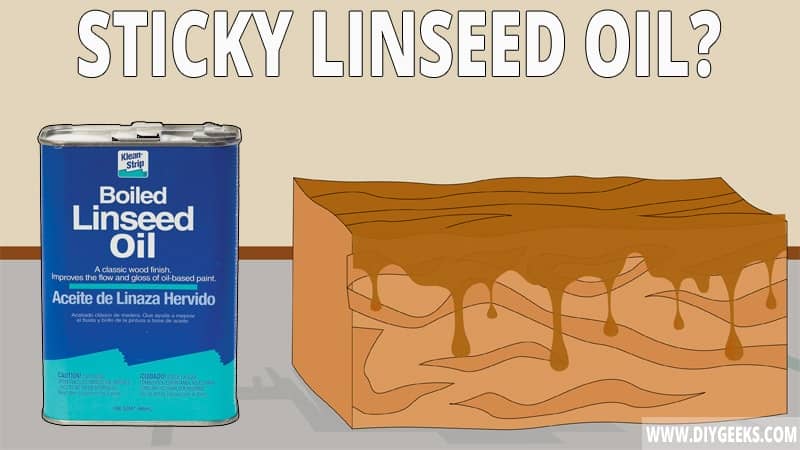Linseed oil is a natural wood oil obtained from the flax plant (Linum usitatissimum) seeds.
The reasons Linseed oil turns sticky include too many coats, improper drying conditions, and improper surface prep.
To fix sticky Linseed oil, use a hairdryer, remove the excess with turpentine, or remove the sticky Linseed oil.
Why Does Linseed Oil Turn Sticky?
Linseed oil turns sticky for the following reasons.
- Too Many Coats.
- Improper Drying Conditions.
- Improper Surface Prep.
- You Applied Raw Linseed Oil.
- Contaminated Linseed Oil.
1. Too Many Coats
Linseed oil turns sticky or remains wet longer if you apply too many coats of it and don’t wipe the excess.
Linseed oil must penetrate the wood pores to adhere and dry, but if you apply too much of it wood can’t absorb all of it. Since wood can’t absorb too much of it, the remaining Linseed oil will stay over the top layer and turn sticky.
It’s recommended to wipe the excess Linseed oil 30 minutes after applying it. If the coating is semi-dry, damp a rag with mineral spirits and wipe the coating.
2. Improper Drying Conditions
For Linseed oil to dry properly and in time, the room temperature must be higher than 50°F (10°C) and humidity levels lower than 50%. If the drying conditions aren’t optimal, the wood oil takes longer to dry and turns sticky (or tacky).
Linseed oil has a thicker viscosity and its solvent (oil) takes longer to evaporate if the temperature is lower or humidity is higher.
To fix this, increase the temperature (heat) around the wood oil coating to accelerate the solvent evaporation rate.
3. Improper Surface Prep
Improper surface prep refers to when the surface isn’t cleaned or dry or if the surface is already sealed before applying the wood oil. Linseed oil takes longer to dry if the surface is dirty, wet, or sealed as it can’t adhere or dry properly.
Linseed oil must penetrate the wood pores to adhere and dry, but if there’s a sealer (or paint) the wood oil can’t penetrate the wood pores and won’t adhere or dry.
If the surface is wet (or exposed to constant water or water leak), the surface moisture will prevent the Linseed oil coating from penetrating, adhering, and drying, creating a sticky finish.
You must clean, dry, and sand to remove the existing finish before applying wood oil.
4. You Applied Raw Linseed Oil
Raw Linseed oil is unprocessed and doesn’t contain fast-drying agents, so it takes longer to dry. Boiled Linseed oil is processed and contains fast-drying agents that make its coating dry faster.
If you apply Raw Linseed oil, the coating will remain wet and turn sticky for longer than Boiled Linseed oil. Simply wipe the excess and wait for the coating to naturally dry.
5. Contaminated Linseed Oil
Linseed oil has a natural formula obtained from the Flax plant seeds and doesn’t welcome contaminants. If the wood oil is affected by grease, dirt, or stains, its coating won’t dry or adhere properly and will turn sticky.
Linseed oil can get contaminated if you improperly store it in dirty storage or if you apply it over a dirty surface.
Does Tacky Linseed Oil Dry Eventually?
Tacky Linseed oil dries eventually if the tackiness is caused by too many coats, improper drying conditions, or if you applied Raw Linseed oil. Simply wipe the excess and increase the heat around the coating to accelerate the solvent evaporation and the coating will dry.
If the sticky finish is caused because the solvent (oil) isn’t evaporating fast enough, simply increase the evaporation rate and the coating will dry eventually.
Tacky Linseed oil doesn’t dry eventually if the tackiness is caused by improper surface prep, or if the Linseed oil is contaminated. If there’s something else, such as a water leak or exposure, preventing the Linseed oil from drying, the wood oil won’t dry unless you fix the issue.
You must remove the finish, fix the surface issues, and re-apply the wood oil.
Also, if Boiled Linseed oil is tacky (or sticky) for more than 48 hours, the finish won’t dry eventually and you must remove it.
How To Fix Sticky Linseed Oil?
To fix sticky Linseed Oil, do one of the following things.
- Use a hair dryer and dehumidifier.
- Remove the Excess with Turpentine.
- Remove the Sticky Linseed oil.
1. Use a Hairdryer and Dehumidifier
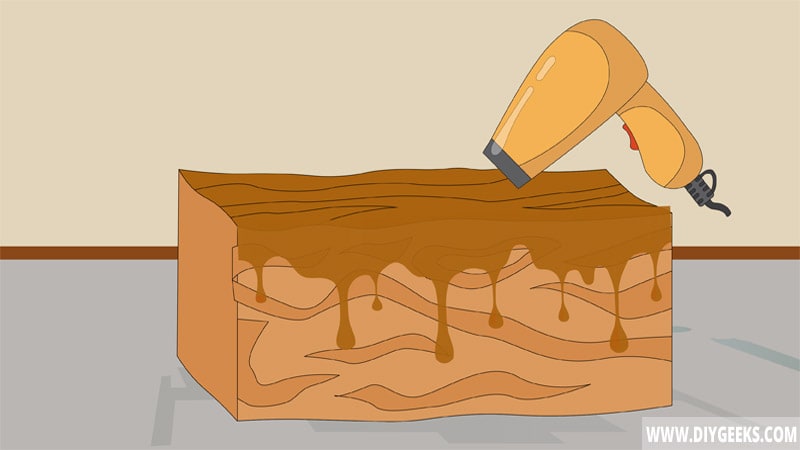
Since Linseed oil dries through solvent evaporation, increasing the heat (temperature) with a hairdryer and decreasing the humidity levels with a dehumidifier will accelerate the solvent evaporation rate and the coating will dry.
Linseed oil uses oil as its solvent, and oil takes too long to evaporate from the coating especially if the temperature is low and the humidity levels are high. If you increase the temperature and lower the humidity levels, the solvent will evaporate faster.
The tools you need for this project are listed below.
- A hairdryer
- Dehumidifier.
Here is a guide to this method:
- Turn on the dehumidifier and place it near the Linseed oil coating.
- Use a hair dryer at a medium temperature.
- Move the hair dryer over the Linseed oil coating for around 5 minutes. Don’t keep it in the same place for too long.
- Wait 30 minutes.
- Use the hair dryer for 5 minutes again.
- Allow the Linseed oil coating to dry naturally.
2. Remove the Excess with Turpentine
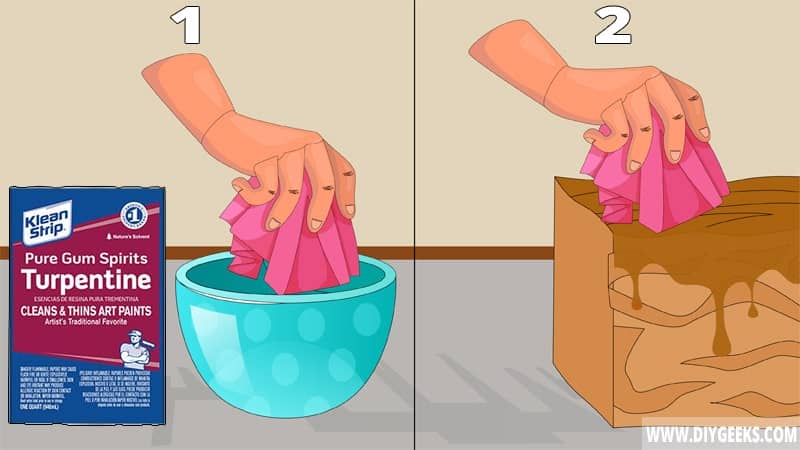
If you apply too many Linseed oil coats, remove the excess with turpentine. Wood can’t absorb too much Linseed oil, so the remaining will stay over the top layer, turn sticky, and prevent the absorbed coating from drying.
You must wipe the excess Linseed oil 30 minutes after applying it to prevent the wood oil from gunking up or turning sticky.
The tools you need for this project are listed below.
- Turpentine or mineral spirits
- Rags
- A clean bowl
Here are the steps for this guide:
- Damp a rag with turpentine or mineral spirits.
- Use the dampened rag to wipe the Linseed oil finish.
- Pour turpentine over the finish.
- Wait 30 minutes.
- Use a dry rag to wipe the finish and remove the excess.
- Allow the remaining coating to dry naturally.
- Touch up the finish with one (1) coat if needed.
Tip: Don’t use alcohol-based paint removers, such as acetone, to dissolve the sticky linseed oil as they will remove the finish completely.
3. Remove The Sticky Linseed Oil
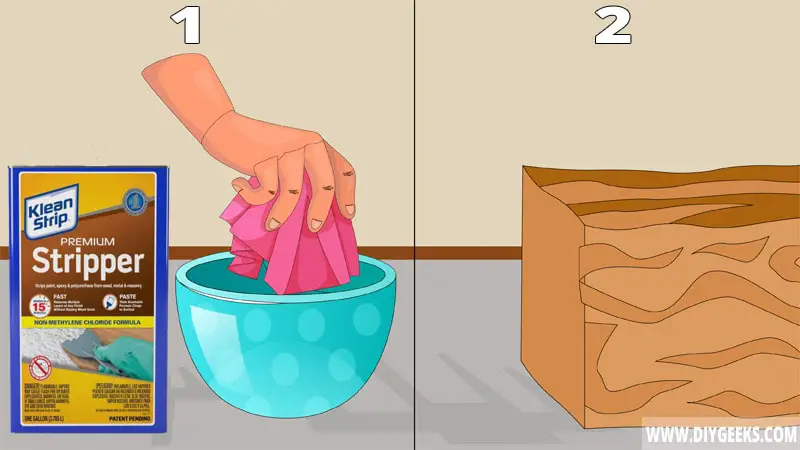
If the sticky Linseed oil is caused by improper surface prep, remove the Linseed oil finish, fix the surface issues, and re-apply it.
A wet or sealed surface will prevent the wood oil from penetrating and adhering, creating a sticky appearance. Unless you remove the moisture or sealer from the surface, the wood oil won’t dry properly.
To remove Linseed Oil, do the following things.
- Pour acetone over the wood oil.
- Scrape the finish with a paint scraper.
- Use coarse-grit sandpaper (40-grit).
- Use solvent-based paint or wood oil remover.
Do You Need To Wipe Excess Linseed Oil From a Surface?
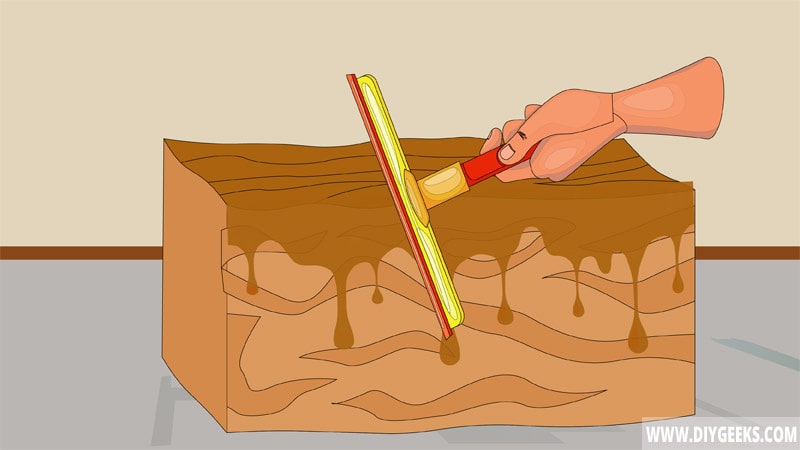
You need to wipe excess Linseed oil from a surface 30 minutes after applying it. This prevents Linseed oil from turning sticky as it removes the excess and allows the remaining coating to dry properly.
Linseed oil must penetrate wood pores to adhere and dry. But, wood can’t absorb too much wood oil as it has small pores. If you don’t wipe the excess, the Linseed oil that didn’t penetrate the coating will remain wet and prevent the soaked coating from drying.
The amount of Linseed oil wood can absorb depends on the wood type. Wood with large pores will absorb more wood oils.
What Happens If You Re-Coat Linseed Oil Too Soon?
If you re-coat Linseed oil too soon, the new coating won’t penetrate or adhere properly and will prevent the existing coating solvent (oil) from evaporating, creating a sticky finish.
Linseed oil dries through solvent evaporation — the solvent (oil) must evaporate fully from the surface and the coating must become hard (rigid) before you re-coat it.
Boiled Linseed oil takes around 24 hours to dry between coats. This gives the solvent enough time to evaporate and the coating to dry and harden so it can support additional coatings.
How To Know If Linseed Oil Is Dry?
To know if Linseed oil is dry, check the following things.
- Inspect the Finish. If the finish doesn’t look wet or reflective, it has dried.
- Check the Color Shade. Dry Linseed oil has a gold, amber-like, or yellowing tone color shade.
- Water-resistance. Pour water over the finish — if the water doesn’t penetrate the coating, the finish has dried.
